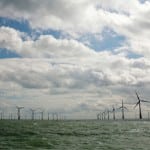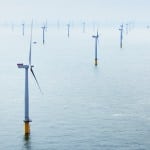The UK will build only a quarter of the 29 GW of offshore wind farms needed to reach its target to have 15% of energy from renewable sources by 2020 unless the government acts urgently to reduce costs and risks to developers, a government-funded but independent think tank said in a report launched last week.
Carbon Trust’s report, “Offshore wind: big challenge, big opportunity,” said that relaxation of the constraints that dictate where offshore wind farms can be built could cut a stunning £16 billion ($27.4 billion) from the overall cost of developing offshore wind.
“Applying all the current constraints would require the UK’s next round of offshore wind farms to be built at great expense 70 miles from the shore and in deep waters. Allowing wind farms to be built nearer to the shore and in shallower waters is the key cost-saving measure that will enable 29 GW of offshore wind farms to be built by 2020,” Carbon Trust said.
Erecting turbines in potentially restricted waters would alone reduce costs by more than 20%, the report suggested.
Its other recommendations included removing grid and regulatory barriers, increasing public R&D funding, and modifying the current incentive mechanism.
The report concluded that these measures collectively could save up to 40% of costs, slashing £30 billion ($51.4 billion) from the total cost of development, which in turn could make offshore wind power competitive with conventional generation before 2020.
Carbon Trust’s report was launched amid concerns last week from the UK media that the country’s plans to make wind energy a prominent aspect of its generation portfolio by 2020 are on the brink of failure.
Investigative reporting by The Observer, a Sunday edition of The Guardian, revealed that planning delays, long delivery times, escalating costs, 10-year hold-ups in connection to the national grid, and technical problems in building offshore wind farms all threaten to derail the country’s ambitions.
Last week, Ed Miliband, the new climate change minister, raised the UK’s target for reducing greenhouse gas emissions by 2050 from 60% to 80%.
But, Britain’s current target to produce 15% of all energy from renewables by 2020 alone would require that wind power—which currently constitutes about 4% of the UK’s power generation—expand to 36% within 12 years. Already, the country was fielding a “severe shortage” of engineers, and companies were reviewing their commitments to wind energy because of spiraling costs, The Observer said.
“The result could be electricity shortages by 2020, failure to meet climate change and energy targets and possible hefty fines from Europe,” the newspaper said.
The Observer stressed that the UK is the first country to attempt to switch its electricity supply so quickly—and on so large a scale. It estimated that to achieve it, the industry would need to build nearly 15,000 turbines, generating 35 GW of electricity, on land and at sea.
“Many experts say it is technically feasible to meet the targets, but there is a growing conviction that the plans were rushed through so quickly by the government that it will now take substantial new money and guarantees to work,” it said.
This hasn’t stopped investments in wind, however. Last week, Masdar, Abu Dhabi’s multimillion-dollar clean technology initiative announced it would grab a 20% stake in the largest of the UK’s planned offshore wind farms, the London Array project.
This project had been proposed for a 90-square-mile site 12 miles off the coast of England, in a Thames estuary. When fully completed, the project could contain up to 341 turbines and generate about 1 GW of electricity.
The project will reportedly cost £2.5 billion ($4.3 billion). Royal Dutch Shell had pulled out of the project in May. Shell’s partners, Germany’s E.ON and Denmark’s Dong Energy, currently own the whole project.
Sources: Carbon Trust, The Observer, London Array










